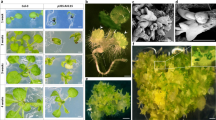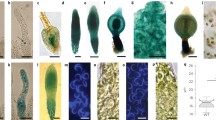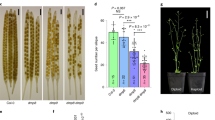Abstract
Asexual seed formation (apomixis) in Hieracium aurantiacum occurs by mitotic embryo sac formation without prior meiosis in ovules (apomeiosis), followed by fertilization-independent embryo and endosperm development. Sexual reproduction begins first in Hieracium ovules with megaspore mother cell (MMC) formation. Apomixis initiates with the enlargement of somatic cells, termed aposporous initial (AI) cells, near sexual cells. AI cells grow towards sexually programmed cells undergoing meiosis, which degrade as the dividing nuclei of AIs obscure and displace them. Following Agrobacterium-mediated transformation of an aneuploid Hieracium aurantiacum apomict, a somaclonal mutant designated “loss of apomeiosis 1” (loa1) was recovered, which had significantly lost the ability to form apomictic seed. Maternal apomictic progeny were rare and low levels of germinable seedlings were primarily derived from meiotically derived eggs. Cytological analysis revealed defects in AI formation and function in loa1. Somatic cells enlarged some distance away from sexual cells and unlike AI cells, these expanded away from sexual cells without nuclear division. Surprisingly, many accumulated callose in the walls, a marker associated with meiotically specified cells. These defective AI (DAI) cells only had partial sexual identity as they failed to express a marker reflecting entry to meiosis that was easily detected in MMCs and they ultimately degraded. DAI cell formation did not lead to a compensatory increase in functional sexual embryo sacs, as collapse of meiotic embryo sacs was prevalent in the aneuploid somaclonal mutant. Positional cues that are important for AI cell differentiation, growth and fate may have been disrupted in the loa1 mutant and this is discussed.




Similar content being viewed by others
References
Albertini E, Porceddu A, Ferranti F, Reale L, Barcaccia G, Romano B, Falcinelli M (2001) Apospory and parthenogenesis may be uncoupled in Poa pratensis: a cytological investigation. Sex Plant Reprod 14:213–217
Bajon C, Horlow C, Motamayor JC, Sauvanet A, Robert D (1999) Megasporogenesis in Arabidopsis thaliana L.: an ultrastructural study. Sex Plant Reprod 12:99–109
Bergman DC (2004) Integrating signals in stomatal development. Curr Opin Plant Biol 7:26–32
Bicknell RA (1994) Micropropagation of Hieracium aurantiacum. Plant Cell Tissue Organ Cult 37:197–199
Bicknell RA (1997) Isolation of a diploid, apomictic plant of Hieracium aurantiacum. Sex Plant Reprod 10:168–172
Bicknell RA, Borst NK (1994) Agrobacterium-mediated transformation of Hieracium aurantiacum. Int J Plant Sci 155:467–470
Bicknell RA, Koltunow AM (2004) Understanding apomixis: recent advances and remaining conundrums. Plant Cell 16:S228–S245
Bicknell RA, Borst NK, Koltunow AM (2000) Monogenic inheritance of apomixis in two Hieracium species with distinct developmental mechanisms. Heredity 84:228–237
Bicknell RA, Lambie SC, Butler RC (2003) Quantification of progeny classes in two facultatively apomictic accessions of Hieracium. Hereditas 138:11–20
Bicknell R, Podivinsky E, Catanach S, Erasmuson S, Lambie S (2001) Strategies for isolating mutants in Hieracium with dysfunctional apomixis. Sex Plant Reprod 14:227–232
Bishop DK, Park D, Xu LZ, Kleckner N (1992) DMC1: a meiosis-specific yeast homolog of E. coli recA required for recombination, synaptonemal complex-formation and cell cycle progression. Cell 69:439–456
Catanach AS, Erasmuson SK, Podvinsky E, Jordan BR, Bicknell R (2006) Deletion mapping of genetic regions associated with apomixis in Hieracium. Proc Natl Acad Sci USA 133:18650–18655
Clark SE, Jacobsen SE, Levin JZ, Meyerowitz EM (1996) The CLAVATA and SHOOT MERISTEMLESS loci competitively regulate meristem activity in Arabidopsis. Development 122:1567–1575
Diatchenko L, Lau YF, Campbell AP, Chenchik A, Moqadam F, Huang B, Lukyanov S, Lukyanov K, Gurskaya N, Sverdlov ED, Siebert PD (1996) Suppression subtractive hybridization: a method for generating differentially regulated or tissue-specific cDNA probes and libraries. Proc Natl Acad Sci USA 93:6025–6030
Ding ZJ, Wang T, Chong K, Bai SN (2001) Isolation and characterization of OsDMC1, the rice homologue of the yeast DMC1 gene essential for meiosis. Sex Plant Reprod 13:285–288
Fletcher JC, Brand U, Running MP, Simon R, Meyerowitz EM (1999) Signaling of cell fate decisions by CLAVATA3 in Arabidopsis shoot meristems. Science 283:1911–1914
Gubler F (1989) Immunofluorescence localization of microtubules in plant root tips embedded in butyl-methyl methacrylate. Cell Biol Int Rep 13:137–145
Hake S, Freeling M (1986) Analysis of genetic mosaics shows that the extra epidermal cell divisionas in knotted mutant maize plants are induced by adjacent mesophyll cells. Nature 320:621–623
Hord CL, Chen Changbin, DeYoung BJ, Clark SE, Ma H (2006) The BAM1/BAM2 receptor-like kinases are important regulators of Arabidopsis early anther development. Plant Cell 18:1667–1680
Kathiresan A, Khush GS, Bennett J (2002) Two rice DMC1 genes are differentially expressed during meiosis and during haploid and diploid mitosis. Sex Plant Reprod 14:257–267
Klimyuk VI, Jones JDG (1997) AtDMC1, the Arabidopsis homologue of the yeast DMC1 gene: characterization, transposon-induced allelic variation and meiosis-associated expression. Plant J 11:1–14
Kobayashi T, Hotta Y, Tabata S (1993) Isolation and characterization of a yeast gene that is homologous with a meiosis-specific cDNA from a plant. Mol Gen Genet 237:225–232
Koltunow AM, Grossniklaus U (2003) Apomixis: a developmental perspective. Ann Rev Plant Biol 54:547–574
Koltunow AM, Bicknell RA, Chaudhury AM (1995) Apomixis: molecular strategies for the generation of genetically identical seeds without fertilization. Plant Physiol 108:1345–1352
Koltunow AM, Johnson SD, Bicknell RA (1998) Sexual and apomictic development in Hieracium. Sex Plant Reprod 11:213–230
Koltunow AM, Johnson SD, Bicknell RA (2000) Apomixis is not developmentally conserved in related, genetically characterised Hieracium plants of varying ploidy. Sex Plant Reprod 12:253–266
Kwak SH, Shen R, Schiefelbein J (2005) Positional signaling mediated by a receptor-like kinase in Arabidopsis. Science 307:1111–1113
Liu Y, Mitsukawa N, Oosumi T, Whittier RF, Liu YG (1995) Efficient isolation and mapping of Arabidopsis thaliana T-DNA insert junctions by thermal asymmetric interlaced PCR. Plant J 8:457–463
Neale MJ, Keeney S (2006) Clarifying the mechanics of DNA strand exchange in meiotic recombination. Nature 442:153–158
Nonomura K, Miyoshi K, Eiguchi M, Suzuki T, Miyao A, Hirochika H, Kurata N (2003) The MSP1 gene is necessary to restrict the number of cells entering into male and female sporogenesis and to initiate anther wall formation in rice. Plant Cell 15:1728–1739
Okada T, Endo M, Singh MB, Bhalla PL (2005) Analysis of the histone H3 gene family in Arabidopsis and identification of the male-gamete-specific variant AtMGH3. Plant J 44:557–568
Rasheed MS, Selth L, Koltunow AM, Randles JW, Rezaian MA (2006) Single-stranded DNA of Tomato leaf curl virus accumulates in the cytoplasm of phloem cells. Virology 348:120–132
Rodkiewicz B (1970) Callose in cell walls during megasporogenesis in angiosperms. Planta 93:39–47
Rojo E, Sharma VK, Kovaleva V, Raikhel NV, Fletcher JC (2002) CLV3 is localized to the extracellular space where it activates the Arabidopsis CLAVATA stem cell signaling pathway. Plant Cell 14:969–977
Rosenberg O (1906) Über die Embryobildung in der Gattung Hieracium. Ber Dtsch Bot Ges 24:157–161
Rosenberg O (1907) Experimental and cytological studies in the Hieracia. II. Cytological studies on the apogamy in Hieracium. Botanisk Tidsskrift 28:143–170
Siebert PD, Chenchik A, Kellogg DE, Lukyanov KA, Lukyanov SA (1995) An improved PCR method for walking in uncloned genomic DNA. Nucl Acid Res 23:1087–1088
Shimazu J, Matsukura C, Senda M, Ishikawa R, Akada S, Harada T, Tabata S, Niizeki M (2001) Characterization of a DMC1 homologue, RiLIM15, in meiotic panicles, mitotic cultured cells and mature leaves of rice (Oryza sativa L.). Theor Appl Genet 102:1159–1163
Skalinska M (1970) Further cytological studies in natural populations of Hieracium aurantiacum L. Acta Bio Crac Ser Bot 13:111–118
Skalinska M (1971) Experimental and embryological studies in Hieracium aurantiacum L. Acta Biol Crac Ser Bot 14:139–155
Skalinska M, Kubien E (1972) Cytological and embryological studies in Hieracium pratense Tausch. Acta Biol Crac Ser Bot 15:39–50
Stewart RN, Dermen H (1975) Flexibility in ontogeny as shown by the contribution of the shoot apical layers to leaves of periclinal chimeras. Am J Bot 62:935–947
Szymkowiak EJ, Sussex IM (1996) What chimeras can tell us about plant development. Annu Rev Plant Physiol Plant Mol Biol 47:351–367
Tucker MR, Paech NA, Willemse MTM, Koltunow AMG (2001) Dynamics of callose deposition and beta-1,3-glucanase expression during reproductive events in sexual and apomictic Hieracium. Planta 212:487–498
Tucker M, Araujo A, Paech N, Hecht V, Schmidt E, Rossell J, De Vries S, Koltunow A (2003) Sexual and apomictic reproduction in Hieracium subgenus Pilosella are closely interrelated developmental pathways. Plant Cell 15:1524–1537
van den Berg C, Willemsen V, Hage W, Weisbeek P, Scheres B (1995) Cell fate in the Arabidopsis root meristem determined by directional signaling. Nature 378:62–65
Wu HM, Cheung AY (2000) Programmed cell death in plant reproduction. Plant Mol Biol 44:267–281
Yang C, Carroll B, Scofield S, Jones J, Michelmore R (1993) Transactivation of Ds elements in plants of lettuce (Lactuca sativa). Mol Gen Genet 241:389–398
Yang SL, Xie LF, Mao HZ, Puah CS, Yang WC, Jiang L, Sundaresan V, Ye D (2003) TAPETUM DETERMINANT 1 is required for cell specialization in the Arabidopsis anther. Plant Cell 15:2792–2804
Yang WC, Sundaresan V (2000) Genetics of gametophyte biogenesis in Arabidopsis. Curr Opin Plant Biol 3:53–57
Acknowledgments
We thank Shawn Jackson for cloning the HDMC1 cDNA fragment from Hieracium. This work was supported by a grant from the New Zealand Foundation for Research Science and Technology and from CSIRO, Australia.
Author information
Authors and Affiliations
Corresponding author
Additional information
Communicated by Thomas Dresselhaus.
The authors Takashi Okada, Andrew S. Catanach and Susan D. Johnson made equal contributions to the data.
Rights and permissions
About this article
Cite this article
Okada, T., Catanach, A.S., Johnson, S.D. et al. An Hieracium mutant, loss of apomeiosis 1 (loa1) is defective in the initiation of apomixis. Sex Plant Reprod 20, 199–211 (2007). https://doi.org/10.1007/s00497-007-0057-5
Received:
Revised:
Accepted:
Published:
Issue Date:
DOI: https://doi.org/10.1007/s00497-007-0057-5




